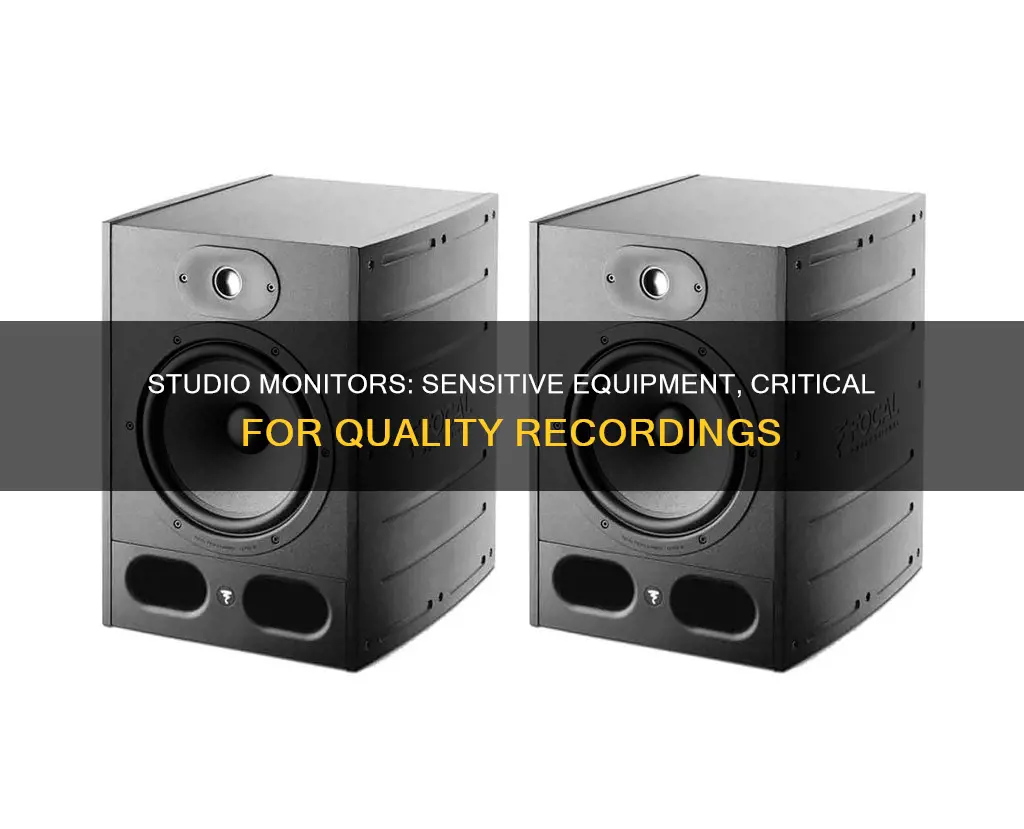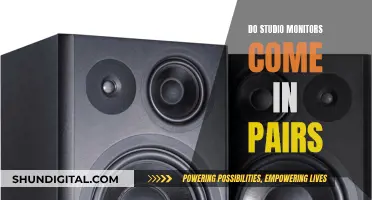
Studio monitors are highly sensitive pieces of equipment, and their sensitivity can be affected by various factors such as input sensitivity, placement, and listening position. They are designed to have a flat frequency response, meaning all frequencies are played at the same volume level, ensuring accurate mixing and mastering. The durability of studio monitors is also a concern, as they can degrade over time and become less accurate. Additionally, noise in the playback stream can be a tricky problem, caused by various factors such as gain or amplification being too high, or issues with the audio interface or power source. When choosing studio monitors, factors such as size, wattage, and budget should be considered to ensure optimal sound quality and compatibility with specific needs.
What You'll Learn

Studio monitors vs Hi-Fi speakers
Studio monitors and Hi-Fi speakers have distinct purposes and characteristics, catering to different audio needs and environments.
Studio monitors, or reference loudspeakers, are designed for critical listening in professional audio settings, such as recording studios, radio stations, and other audio production environments. They aim to provide a flat frequency response, ensuring that all frequencies are played at the same volume level. This accuracy in frequency reproduction is crucial for mixing, allowing engineers to create balanced mixes that will sound consistent across various playback systems. Studio monitors are typically active speakers, featuring built-in amplifiers, and are designed for near-field listening, providing a precise, immediate sound when positioned close to the listener.
On the other hand, Hi-Fi speakers, or regular loudspeakers, are intended for home and car audio systems, as well as entertainment venues. They are designed to enhance the listening experience by emphasising certain frequencies, such as boosting bass and treble, resulting in a "smiley curve" frequency response. This alteration of the sound makes the music seem more powerful and crisp. Hi-Fi speakers are usually passive, requiring external power amplifiers, and are often placed in various locations around a room without significant sound quality degradation.
In terms of durability, both studio monitors and Hi-Fi speakers have similar susceptibility to breakage. However, the useful lifetime of studio monitor transducers (woofers and tweeters) and internal amplifiers is measured in decades when used in non-touring and non-EDM club settings.
While studio monitors excel at accuracy and precision, Hi-Fi speakers focus on delivering an enjoyable listening experience. Studio monitors are ideal for audio professionals who require an unbiased, detailed sound for mixing and mastering. In contrast, Hi-Fi speakers cater to music enthusiasts who want to experience music with enhanced bass and treble, creating a vibrant and immersive atmosphere.
Dismantling a ViewSonic LCD Monitor: Step-by-Step Guide
You may want to see also

Active vs passive monitors
Studio monitors are available in two varieties: active and passive. While there is no clear winner between the two, understanding their differences can help you decide which one is more suitable for your needs.
Passive monitors are modular in nature, requiring users to match them with an appropriate amplifier and crossover. This means that the two components of your monitoring system — the speakers and the amp — can be upgraded separately, allowing a more gradual and less expensive progression to better-quality gear. Passive monitors are also more flexible since they allow you to choose an external amplifier that perfectly matches your monitors.
On the other hand, active monitors have built-in amplifiers, making them simpler to use and set up. They don't require any additional equipment, such as amplifiers or cables, and can be used right out of the box. Additionally, the built-in amplifiers in active monitors are designed specifically for the monitors, which can lead to better overall sound quality.
In the middle and upper parts of the monitor market, active monitors offer significant advantages over passive designs, such as optimised power amps for each driver, optimised driver-protection circuitry, and more complex and precise line-level crossovers. However, at the budget end of the market, these advantages may be overshadowed by the need to achieve a low sale price, resulting in poor-quality power amps and power supplies.
While the recording industry grew up with passive monitors, countless professional studios worldwide now rely on active systems. Unless you have a specific reason to prefer a passive system, you'll likely appreciate the convenience and performance offered by an active studio monitoring system.
How to Monitor Data Usage on iPhone 6
You may want to see also

Amplifier configurations
The single-amp configuration is the simplest setup, typically used for passive monitors. In this configuration, the left and right speakers are powered by a single amplifier, usually integrated into one of the speakers. This setup is common for computer speakers but rarely used for studio monitors.
The bi-amp configuration is more common for active monitors and offers greater control over frequency response and more precise sound reproduction. In a bi-amp setup, each driver has its own dedicated amplifier, allowing for better control over the frequency response. This configuration is often used in professional studios where accuracy and detail are essential.
The tri-amp configuration is the most advanced and complex of the three. In this setup, each driver in a 3-way speaker (woofer, midrange, tweeter) has its own dedicated amplifier for low, mid, and high frequencies. This provides the ultimate control over frequency response and the most precise sound reproduction. Tri-amp configurations are typically used in high-end professional studios where the highest level of accuracy is required.
When choosing an amplifier configuration, it is important to consider the size of the room, the music style, and the desired level of precision and flexibility. For home studios, 5-inch speakers are generally recommended. The amplifier power and speaker placement are also important factors that can impact the overall sound quality of the studio monitors.
How LCD Monitors Handle Frequency Interference
You may want to see also

Monitor size
The size of studio monitors should be chosen based on the size of the room and the music style. For home studios, 5-inch speakers are a good fit. If you are an EDM music producer, you will require better low-frequency response, and therefore, a bigger driver size would be more suitable. This is because larger speakers are capable of moving more air, which is necessary for reproducing lower-frequency sounds.
On the other hand, smaller speakers may offer better midrange and high-frequency response, as they can reproduce these frequencies more accurately due to their smaller size. If you categorise music genres by speaker size, EDM, pop, and hip-hop are recommended for 8-inch speakers. Rock, indie, and jazz are recommended for 6-inch speakers, while classical and acoustic are recommended for 5-inch speakers.
Speaker size is not the only factor that determines sound quality. Other factors, such as driver quality, amplifier power, and speaker placement, can also have a significant impact on the overall sound of your studio.
Identifying Monitor Ports: HDMI or DVI?
You may want to see also

Monitor placement
The placement of your studio monitors is crucial to achieving the best sound quality and accuracy. Here are some tips to consider for optimal monitor placement:
- Symmetry: Place your monitors symmetrically in the room, preferably along the short wall to minimise sonic reflections.
- Listening Position: The ideal listening position is centred between the sidewalls to achieve a balanced stereo image. Avoid sitting in the exact centre of the room, as this will create a "null" due to the room's fundamental frequency or its harmonics.
- Height: Position the tweeters of your monitors at ear level, typically between 1.2 and 1.4 metres from the floor. This ensures the most consistent and accurate sound.
- Angle: For standard stereo setups, the angle between the left and right monitors should be 60 degrees, with both monitors aimed towards the listening position.
- Stands: Use stands to elevate your monitors to ear level. Isolation stands can also help reduce vibrations and improve sound quality.
- Avoid Reflections: Minimise reflections from nearby hard surfaces such as windows, drywall, and mirrors. Use acoustic treatments like foam panels to absorb sound and reduce reflections.
- Avoid Early Reflections: Place the monitors behind the console or desktop to avoid early reflections. If placed on the desktop, use foam blocks to minimise coupling with the desk.
- Fine-Tuning: Use room-tuning software or play music through the monitors to identify problematic "modes" or resonances in the room. Adjust monitor placement accordingly.
- Listening Tests: Play professionally recorded music through your monitors to verify the accuracy of your setup and make any necessary adjustments.
Disassembling LCD Monitors: Step-by-Step Guide for Beginners
You may want to see also
Frequently asked questions
To avoid noise, you should check the levels of your interface, software, and speakers to make sure that nothing is being over-amplified. Additionally, ensure that your monitors are connected to a different power source than your computer and other digital hardware.
To avoid distortion, set your input sensitivity lower, for example, to +4 dBu. This will allow your amp to handle stronger signals. Setting your sensitivity to the highest point, typically -10 dBu, means no attenuation will be applied.
Studio monitors can last for decades. However, it is important to note that studio speakers may degrade over time and become less accurate, delivering a more "coloured" sound.
Studio monitors are specifically designed for use in recording studios and professional audio environments. They have a flat frequency response, meaning that all frequencies are played at the same volume level, allowing for accurate mixing and mastering. Regular Hi-Fi speakers, on the other hand, are designed to emphasise certain frequencies, such as adding more bass, to create an enhanced listening experience.







